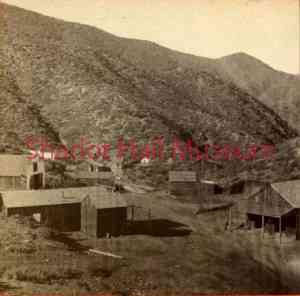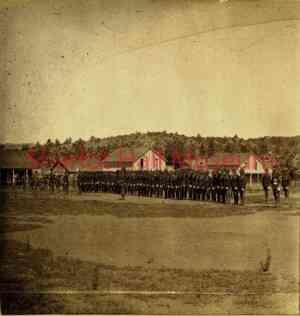By Eric Jacobson
George Emory Goodfellow (1855-1910) was a frontier physician who became the United States’ foremost expert on the treatment of gunshot wounds.
Goodfellow attended Wooster University Medical School in Cleveland, Ohio, graduating in 1876. That same year, George joined his father Milton in Yavapai County, Arizona, where Milton was a mining executive with the Peck Mine Company. The mine in the Bradshaw Mountains produced $1.5 Million dollars in silver (approximately $37 million dollars today) between 1875-1885. For two years George was the Peck Mine Company doctor.
 Restless, George agreed to serve with George Armstrong Custer’s 7th Cavalry in 1876. Luckily for him, his orders were delayed, and he missed the Battle of the Little Bighorn on June 25, 1876. Instead, Dr. Goodfellow became assistant surgeon at Fort Whipple in Prescott.
Restless, George agreed to serve with George Armstrong Custer’s 7th Cavalry in 1876. Luckily for him, his orders were delayed, and he missed the Battle of the Little Bighorn on June 25, 1876. Instead, Dr. Goodfellow became assistant surgeon at Fort Whipple in Prescott.
There he treated all types of injuries, including gunshot and stab wounds, rattlesnake, and scorpion bites, plus accidents involving explosives, wagons, and horses.
In 1876, Dr. George Goodfellow married Kate Colt, a cousin to Samuel Colt, inventor of the Colt revolver known as the Peacemaker. The couple soon had two children, Edith, and George.
In 1880, Goodfellow terminated his army contract and opened his own medical practice in Tombstone, Az. Many of the Tombstone residents were outlaws and cowboys with Confederate roots. The lawmen, however, including Virgil, Morgan, and Wyatt Earp, were Republicans from the northern states. Dr. Goodfellow later said that Tombstone was the “condensation of wickedness.”
On October 26, 1881, Goodfellow treated Virgil and Morgan Earp for gunshot wounds from the Gunfight at the O.K. Corral. When the Earps were accused of murder after the incident, Goodfellow testified in court that the Earp wounds were in self-defense, not murder as cowboy Ike Clanton claimed. In revenge, two months later, Virgil was shot in the back and left arm by the cowboys. Then Morgan was shot and died from his wounds. Goodfellow did everything possible to save Morgan but he was unsuccessful.
 Uniquely for the time, Dr. Goodfellow insisted on sterile techniques in treating gunshot wounds. Routinely, George would wash the patient’s wound with lye soap or whisky. On July 4, 1881, he successfully treated a Tombstone miner who was shot in the stomach nine days earlier. The small incisions Dr. Goodfellow made in the victim’s stomach became known as a laparotomy. A laparotomy is the standard treatment for abdominal gunshot wounds to this day.
Uniquely for the time, Dr. Goodfellow insisted on sterile techniques in treating gunshot wounds. Routinely, George would wash the patient’s wound with lye soap or whisky. On July 4, 1881, he successfully treated a Tombstone miner who was shot in the stomach nine days earlier. The small incisions Dr. Goodfellow made in the victim’s stomach became known as a laparotomy. A laparotomy is the standard treatment for abdominal gunshot wounds to this day.
Another discovery made by Dr. Goodfellow was that silk acted as protection from bullets. While examining a patient shot in the neck, George noticed two shotgun pellets but no holes in the silk handkerchief around the man’s neck. Goodfellow documented this and other cases in an article entitled, “Notes on the Impenetrability of Silk to Bullets,” for the Southern California Practitioner Journal.
Dr. Goodfellow performed the first appendectomy in the Arizona Territory in 1891. Later that year he developed a procedure called perineal prostatectomy to remove an enlarged prostate. Goodfellow completed 78 operations throughout the USA and only two patients died. He was also one of the first surgeons to develop a spinal anesthesia by mixing cocaine in spinal fluid and injecting the liquid into the patient’s spine.
In addition to his medical practice, Goodfellow was a naturalist. His research into Gila Monster venom was published in the Scientific American Journal. Prior to 1891, it was commonly believed that a Gila Monster bite was fatal. In that year, he provoked one of his lizards to bite him. Although Goodfellow spent the next five days in bed, he did recover.
Dr. George Goodfellow is recognized as the USA’s first nonmilitary trauma surgeon. Goodfellow died on December 7,1910, after a short illness. The University of Arizona School of Medicine established the George Goodfellow Society in his honor.
Days Past” is a collaborative project of the Sharlot Hall Museum and the Prescott Corral of Westerners International (www.prescottcorral.org). This and other Days Past articles are also available at archives.sharlothallmuseum.org/articles/days-past-articles/1. The public is encouraged to submit proposed articles and inquiries to dayspast@sharlothallmuseum.org. Please contact SHM Research Center reference desk at 928-445-3122 Ext. 2, or via email at archivesrequest@sharlothallmuseum.org for information or assistance with photo requests.


